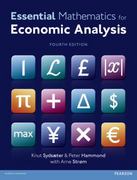A chooser option is a derivative that becomes either a call option or a put option at the choice of the holder at some specified future date. In this question it is helpful to use precise notation to avoid confusion. S(t) denotes the price of the underlying stock at time t. Let CltS(t), KT) denote the price at time t of a European call option with a strike price of K and expiration time T. Let P(t, S(6), KT) denote the price at time t of a European put option with a strike price of K and expiration time T Let H(t, S(8), K, T, T) denote the price at time to a chooser option, for which the holder chooses at time t between a call and a put with strike price and expiration time T. Consider the following chooser option: At time = 1, the holder will choose whether the option becomes a European call option or a European put option with a strike price of $100 and expiration at time T - 3. Today, at time t = 0. the price of the stock is $95 and the price of the chooser option is $20 (Using the above notation H(0,95, 100,1, 3) = 20) The interest rate is zero. (a) Explain why (1,8(1), 100, 1, 3) = max(c(1, S(1), 100, 3), P(1, (1), 100, 3)] That is explain why the value at time t 1 of this chooser option is equal to the greater of the call and put option values C(1, S(1), 100, 3) and P(1, S(1), 100, 3). (b) Show that max[A, B] = A + max(0, B - A) for any real numbers A and B. So, in particular, it follows that max(C(1,8(1), 100,3), P(1, S(1), 100,3) C(1, S(1), 100,3) + max[0,P(1,8(1), 100, 3) - C(1, S(1), 100,3) c) C(0,95, 100, 1) - 4. find C(0,95, 100,3), the time to price of a call option with a strike price of $100 and expiration at time I = 3. (Hint: Remember the given information H(0,95, 100, 1,3) -- 20, then combine part (a) and part (b), recall the fundamental pricing formula at the end of the formula sheet, and use put-call parity twice.) A chooser option is a derivative that becomes either a call option or a put option at the choice of the holder at some specified future date. In this question it is helpful to use precise notation to avoid confusion. S(t) denotes the price of the underlying stock at time t. Let CltS(t), KT) denote the price at time t of a European call option with a strike price of K and expiration time T. Let P(t, S(6), KT) denote the price at time t of a European put option with a strike price of K and expiration time T Let H(t, S(8), K, T, T) denote the price at time to a chooser option, for which the holder chooses at time t between a call and a put with strike price and expiration time T. Consider the following chooser option: At time = 1, the holder will choose whether the option becomes a European call option or a European put option with a strike price of $100 and expiration at time T - 3. Today, at time t = 0. the price of the stock is $95 and the price of the chooser option is $20 (Using the above notation H(0,95, 100,1, 3) = 20) The interest rate is zero. (a) Explain why (1,8(1), 100, 1, 3) = max(c(1, S(1), 100, 3), P(1, (1), 100, 3)] That is explain why the value at time t 1 of this chooser option is equal to the greater of the call and put option values C(1, S(1), 100, 3) and P(1, S(1), 100, 3). (b) Show that max[A, B] = A + max(0, B - A) for any real numbers A and B. So, in particular, it follows that max(C(1,8(1), 100,3), P(1, S(1), 100,3) C(1, S(1), 100,3) + max[0,P(1,8(1), 100, 3) - C(1, S(1), 100,3) c) C(0,95, 100, 1) - 4. find C(0,95, 100,3), the time to price of a call option with a strike price of $100 and expiration at time I = 3. (Hint: Remember the given information H(0,95, 100, 1,3) -- 20, then combine part (a) and part (b), recall the fundamental pricing formula at the end of the formula sheet, and use put-call parity twice.)







